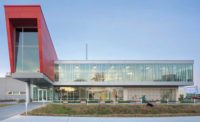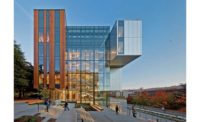2024 California Best Projects
Project of the Year Finalist: Tarzana Reimagined

Photo by RMA Architectural Photography
Tarzana Reimagined
Tarzana, Calif.
BEST PROJECT, HEALTH CARE
Submitted by: McCarthy Building Cos.
Owner: Providence Cedar Sinai Medical Center
Lead Design Firm: Perkins&Will
General Contractor: McCarthy Building Cos.
Civil/Structural Engineer: KPFF Consulting Engineers
MEP Engineer: Syska Hennessy Group
Associate Architect (Seismic Upgrade): Taylor Design
Inspector of Record: RF10 Inspection Inc.
At $448 million, Tarzana Reimagined is the San Fernando Valley’s largest ever health care project. The Providence Cedars-Sinai Tarzana Medical Center has served the growing San Fernando Valley community since 1973. Scope of work on this expansive effort included construction and renovations across 400,000 sq ft of clinical space, with a new replacement tower, main entry building and parking structure. Crews also performed a seismic retrofit of the existing campus as well as various campus improvements and renovations.
The team “overcame several challenges in delivering [the project], including limited site area for construction and the need to maintain full hospital operations throughout the build,” says Eric Brossy de Dios, associate principal and senior project manager at Perkins&Will.
At the core of this expansion and modernization project is the Friese Family Tower, which features 150 private rooms, an expanded emergency department, a pharmacy, a pediatric unit and specialized cardiovascular, critical care and progressive care units. Several new sustainability features were incorporated into the tower that were new to the overall campus, such as energy efficient lighting and controls and heat recovery chillers to utilize waste heat for air-conditioning.

Photo by RMA Architectural Photography
The main entry building revitalized the campus exterior and primary public entrance with the addition of a covered entrance, lobby, gift shop, chapel, admittance center, nuclear medicine/gastrointestinal treatment suite and prep and recovery suite.
A new central utility plant modernizes the campus infrastructure and a 185,000-sq-ft, 600-stall parking structure improves vehicular circulation by separating the emergency drop-off and main entrance from dedicated parking areas.
“Health care construction is inherently challenging, especially when operating within an active campus,” says Erik Chessmore, vice president at McCarthy. “Delivering successful results in such an environment necessitates an unwavering commitment to patient care, a collaborative spirit and innovative problem-solving from a team [that] is laser-focused on a common goal.
A challenging master plan translated into complex phasing and overlapped projects, milestones and utility upgrades. The Tarzana team also had to ensure projects were completed ahead of seismic compliance deadlines, accomplished through partnering with local and state officials to establish priorities that balanced patient care with the required campus upgrades throughout the six-year timeline.

Photo by RMA Architectural Photography
Work was set to begin on the seismic project in March 2020, but would have temporarily impacted the respiratory therapy department. With the pandemic in full swing, the team had to reprioritize the schedule to support the hospital’s immediate needs.
Ensuring worker safety was also critical, especially given the local area’s tendency to reach temperatures above 100°F. Installing permanent shade structures such as canopies between storage containers equipped with cooling fans and spray misters helped keep everyone cool. Across 2.3 million worker hours, the team logged an OSHA recordable incident rate of 0.26, with zero lost-time accidents.
Interim life safety measures helped ensure patient and employee safety throughout construction as well.
The team combined these measures with two other planning tools: area disruption notices, which define the separation of construction activities from active areas, and methods of procedure, which defines the methods to be used on and around active utilities. Despite the extended project duration, patient care was never impacted by construction activities. Crews completed all work within budget in September 2023.



